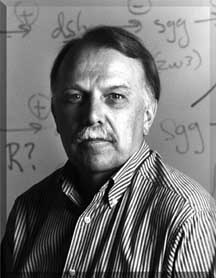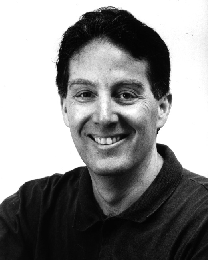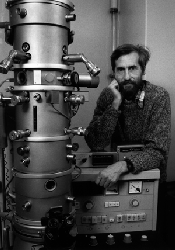Howard Hughes Grant
for Undergraduate Programs
Undergraduate programs in biology on this campus have
been given big boosts by grants from the Howard Hughes Medical Institute's
Undergraduate Biological Science Education Program. Two consecutive
grants, totaling $2.2 million, have had an enormous impact on undergraduate
education in biology.
 Under the direction of Dr. Rod Murphey, Professor
of Biology and Director of the Molecular and Cellular Biology Graduate Program,
the grants have made possible dramatic improvements in equipment available
to undergrads, and assisted in development of the Microbiology and Molecular
Biology Laboratory Support Services which runs a state of the art lab for
molecular studies. They also have supported expansion of the
research experiences for undergraduates. Students at all levels, from
freshmen to seniors, are now working in faculty research labs during the academic year, and
have the opportunity to spend 10 weeks during the summer on research projects
in chemistry, biology, neuroscience, and molecular biology.
Students in these summer Research Experience for Undergraduates programs
receive $250 per week; they work full time in faculty labs and participate in seminars
with other students and faculty. During the last academic year, 170 students
worked in over 60 labs.
Under the direction of Dr. Rod Murphey, Professor
of Biology and Director of the Molecular and Cellular Biology Graduate Program,
the grants have made possible dramatic improvements in equipment available
to undergrads, and assisted in development of the Microbiology and Molecular
Biology Laboratory Support Services which runs a state of the art lab for
molecular studies. They also have supported expansion of the
research experiences for undergraduates. Students at all levels, from
freshmen to seniors, are now working in faculty research labs during the academic year, and
have the opportunity to spend 10 weeks during the summer on research projects
in chemistry, biology, neuroscience, and molecular biology.
Students in these summer Research Experience for Undergraduates programs
receive $250 per week; they work full time in faculty labs and participate in seminars
with other students and faculty. During the last academic year, 170 students
worked in over 60 labs.
The importance of the undergraduate research experience
is confirmed by our own survey of recent graduates. Virtually
all students who have had this experience have gone on to graduate or medical school,
or have obtained research positions after graduation.
 The grants have also supported the development of the Biology
Computer Resource Center (BCRC) (see article on page 3) and a variety
of outreach programs, including a Summer Institute for High School Teachers
administered by Dr. Bruce Byers, and special programs for high school
students, particularly those from Springfield schools.
The grants have also supported the development of the Biology
Computer Resource Center (BCRC) (see article on page 3) and a variety
of outreach programs, including a Summer Institute for High School Teachers
administered by Dr. Bruce Byers, and special programs for high school
students, particularly those from Springfield schools.
|
Botany + Zoology = Biology?
Except for those of you who are recent grads or among those who received our
newsletter of 1994, it may seem this newsletter is coming from a department
you do not know. Six years ago, Botany and Zoology faculty joined to
form a Biology Department, with Dr. Steve Kaulenas (former Head of Zoology)
as Head, and Dr. James Walker (former Head of Botany) as Associate Head.
After completion of Dr. Kaulenas' term, Dr. Chris Woodcock took the Headship.
In order to keep some sense of unity in the plant field, a Plant Biology
Graduate Program (PBGP) was formed within the new Biology Department.
During the 1997-1998 academic year, the PBGP became campus-wide
for all faculty working in the plant field. The current director of the PBGP,
Dr. Peter Hepler, is a 20 year faculty member of the University and Ray
Ethan Torrey Professor of Botany.
The merger of the Botany and Zoology Departments was just one of the
administrative changes which have occurred on this campus in recent years. As in higher
education elsewhere in the United States, major efforts
are being made to reduce isolation between departments and "blur" departmental
boundaries.
The Molecular and Cellular Biology Program, which has been in
existence for more than 15 years, was the first of the graduate programs to cross
departmental lines. It was followed by the Neuroscience and
Behavior Program.
As Botany and Zoology were being united, the Program in
Organismic and Evolutionary Biology came into existence. Now, with the creation
of these four graduate programs,
virtually all faculty in the life sciences have another potential
"home" in one of the programs.
Although the latter are all graduate programs,
they have had a major impact on our undergraduate programs; they have led to
undergraduate seminars in these fields, and increased opportunities
for undergraduates to work in faculty research labs during the summer and academic
year. Since the graduate programs have become central to the development
of the life sciences on our campus, in future issues of this newsletter,
we will provide a more detailed picture of them.
|

Message
from
Chair
Chris
Woodcock
Dear alumni and friends,
Welcome to the first of a regular series of Newsletters to keep you
up to date with events in the Biology Department, and in touch with each other.
We aim to establish a web-based network of alumni through which you can
communicate with classmates, and which will also serve as a
forum for discussion.
As you can see from the lead article, Biology is a young department
|
on Campus. Since our merger, we have seen a three-fold
increase in number of majors, and a similar increase in faculty
scholarship, measured by grant activity and publications
in journals, four Nature papers in two years!
Recent innovations
include the establishment of the BCRC (Biology Computer
Resource Center), development of a new curriculum based on
learning goals, and renovation of the Intro Biology
teaching labs to promote enquiry- based learning.
We want to make the newsletter of interest and use to our alumni, and
would like to hear the sort of things you like to read about.
Would you prefer articles on the
|
current activities of former friends
and colleagues, or news about ‘hot’ items of local research?
Would you be interested in visiting the campus, maybe
with a group from your year? Could you write a short article
for the newsletter? Let us know how to adjust the style and
content of your Alumni Newsletter.
If your Newsletter arrived by mail, you may like to check out your
alumni web site which includes the letter, an event calendar, as well as
links to additional info at URL:
www.bio.umass.edu/biology/alumni.
We also set up a forum for Email conversations. To subscribe to your
Alumni Email Forum, simply send an Email message to:
|
majordomo@bio.umass.edu with the words subscribe alumni_forum in the body of
the message. You will receive a message back with details of the system.
If you can access Newsletters via the web, please let us know - reducing the
number of printed copies and postage (there are over 6,000 Alumni)
will funnel more resources into education, our primary mission.
PS. Those who were on campus in the 80’s may recognize the Siemens 102
electron microscope (left) which did 12 years of yeoman service,
was replaced in 1988 and is now in a DC museum!
|






